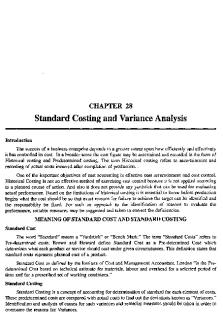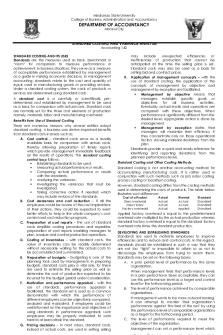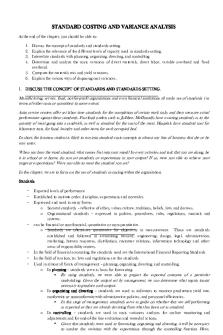Variance and standard deviation PDF

| Title | Variance and standard deviation |
|---|---|
| Author | Brian Choo |
| Course | Business and Economic Statistics |
| Institution | University of New South Wales |
| Pages | 3 |
| File Size | 184.1 KB |
| File Type | |
| Total Downloads | 103 |
| Total Views | 194 |
Summary
Download Variance and standard deviation PDF
Description
Variance and standard deviation for a population -
The calculation of variance and standard deviation involves considering how far each data value is from the mean and describing this dispersion on average.
-
The other two measures of variability, range and interquartile range, describe spread in terms of the range between two values with no reference to the mean.
1. Calculate the mean 2. Subtract the mean from each value of data (observation) = deviation from the mean (x − �)
For any set of data, the sum of all deviations from the arithmetic mean is always zero. This property requires considering alternative ways of obtaining measures of variability from the mean that are averaged over the set of all observations. Therefore, to force the sum of (x − �) to have a non-zero total, we take the squared value of each deviation from the mean (x − �). [also because absolute value is hard to manipulate] 3. Calculate the variance (average of the squared deviations from the mean for a set of numbers)
The sum of the squared deviations from the mean of a set of values — called the
As variance is expressed in terms of squared units of measurement, it is problematic to interpret. Therefore, variance can only be considered an intermediate calculation in the process of obtaining the standard deviation. 4. Calculate the standard deviation
Standard deviation is the square root of the variance. The population standard deviation is denoted by the lowercase Greek letter sigma �.
¿
√
SS N
One main feature of standard deviation is that it is expressed in the same units as the raw data, whereas the variance is expressed in those units squared. we can think of a standard deviation as an estimate of the average distance that individual values are away from the mean. Application of standard deviation: Empirical rule It states how many percentages of observations are within �±x� where x can be 1, 2 or 3. The normal distribution is a unimodal and symmetrical distribution that is often referred to as the bell-shaped distribution. The bell shape is more obvious in the standardised normal distribution, which has a mean of zero and standard deviation of 1.
Another useful application of the empirical rule is in detecting potential outliers. Population versus sample variance and standard deviation Both the sample variance and sample standard deviation use n − 1 in the denominator instead of n, because using n in the denominator of a sample variance results in a statistic that tends to underestimate the population variance. Z-score A z-score represents the number of standard deviations that a value (x) is above or below the mean of a set of numbers.
If a z-score is negative, the raw value (x) is below the mean. If the z-score is positive the raw value (x) is above the Coefficient of variation The coefficient of variation (CV) is a descriptive summary measure that is the ratio of the standard deviation to the mean expressed as a percentage
-
A relative comparison of a standard deviation with its mean
-
Useful in comparing standard deviations that have been calculated from data with different magnitudes or in different units
With large observations, a standard deviation of 5 means nothing. However, with small observations, a standard deviation of 5 can mean a lot. Therefore, we use coefficient of variation for comparisons. The higher the coefficient of variation, the more variations....
Similar Free PDFs

Variance and standard deviation
- 3 Pages

Standard-costs-and-variance-analysis
- 14 Pages

P01 Standard Costs and Variance Analysis
- 161 Pages
Popular Institutions
- Tinajero National High School - Annex
- Politeknik Caltex Riau
- Yokohama City University
- SGT University
- University of Al-Qadisiyah
- Divine Word College of Vigan
- Techniek College Rotterdam
- Universidade de Santiago
- Universiti Teknologi MARA Cawangan Johor Kampus Pasir Gudang
- Poltekkes Kemenkes Yogyakarta
- Baguio City National High School
- Colegio san marcos
- preparatoria uno
- Centro de Bachillerato Tecnológico Industrial y de Servicios No. 107
- Dalian Maritime University
- Quang Trung Secondary School
- Colegio Tecnológico en Informática
- Corporación Regional de Educación Superior
- Grupo CEDVA
- Dar Al Uloom University
- Centro de Estudios Preuniversitarios de la Universidad Nacional de Ingeniería
- 上智大学
- Aakash International School, Nuna Majara
- San Felipe Neri Catholic School
- Kang Chiao International School - New Taipei City
- Misamis Occidental National High School
- Institución Educativa Escuela Normal Juan Ladrilleros
- Kolehiyo ng Pantukan
- Batanes State College
- Instituto Continental
- Sekolah Menengah Kejuruan Kesehatan Kaltara (Tarakan)
- Colegio de La Inmaculada Concepcion - Cebu












